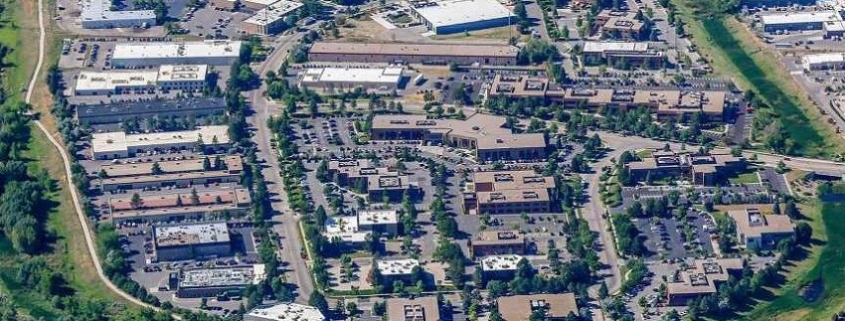BioMed Realty Buys 1 Million-Square-Foot Flatiron Park Portfolio In Boulder
After about six months on the market, a large portfolio within Boulder’s Flatiron Park business center has been purchased by BioMed Realty LLC.
The roughly 1,000,000-square-foot, 22-building campus was sold by Crescent Real Estate LLC and is home to a slew of technology companies. Apple Inc. is suspected to occupy as much as 240,000 square feet of space in the east Boulder park.
“This is an exciting transaction for Boulder and shows that Boulder’s getting a lot of national recognition,” Crescent senior vice president Ben Molk told BizWest.
The sale has yet to be recorded with Boulder County, so no price was immediately available. However, several commercial real estate brokers familiar with the offering told BizWest last year that Crescent was seeking at least $600 million.
Jones Lang LaSalle Inc. brokered the deal. Lionstone Investments LLC and Goldman Sachs Group Inc. also owned portions of the portfolio sold to BioMed. The sale was a joint venture between Crescent and those two groups. Crescent will remain involved in the portfolio as property manager and will likely dip another investment toe in the Boulder waters soon.
“We are absolutely buyers of real estate still, and we are big believers in Boulder,” Molk said. “We’re actively looking for a deal in the market.”
BioMed Realty is a Blackstone portfolio company that owns about 13.7 million square feet of commercial space throughout the country, according to a news release touting the Flatiron Park acquisition.
“With this significant investment in Boulder, we’re delighted to become a part of this innovation-based community,” Jon Bergschneider, president of West Coast markets at BioMed Realty, said in the release. “In addition to BioMed’s initial investment, BioMed anticipates investing an additional $200 million in redevelopment costs over time, which is expected to create nearly 400 new local construction jobs. Beyond being a preeminent regional tech and life sciences hub, Boulder is a thriving community that couples innovation with a profound respect for natural resources and sustainable practices. We look forward to joining and supporting the Boulder community by not only providing best-in-class workspaces for companies to continue their life-saving and inventive work, but also by creating strong, long-term relationships with local organizations working to maintain Boulder’s unique identity as a gem in the Rockies. About 15% of Flatiron Park is home to life sciences tenants and part of BioMed’s investment will be upgrading buildings to bring that percentage closer to 50%.”
Flatirons Park is San Diego-based BioMed’s only property in Colorado. The company’s portfolio is centered on six regions, including California’s Bay Area, Seattle and the New York metro area.
“What we focus on is innovation and technology clusters,” Bergschneider told BizWest. “Historically those have been in the East and West Coast markets. It’s been with great interest and enthusiasm that we’ve continued to watch the Boulder area grow.”
The Flatiron Park deal is likely not BioMed’s last in the Boulder Valley.
“We think of this as an opportunity to enter the market with size and scale and by no means is (the Flatirons Park acquisition) the end of our investment tolerance,” Bergschneider said.
As the local portfolio grows, BioMed, which also has a development arm, may consider adding administrative and support offices in Colorado.
“Boulder has always been a market to watch, driven by highly educated talent, robust capital flow, an existing base of life science and tech pioneers and great quality of life,” BioMed vice president of leasing Mike Ruhl said in a statement. “As demand for office and lab space in the region continues to grow, we believe BioMed’s integrated platform and expertise is uniquely suited to support companies as they continue to scale in this key market. We welcome the opportunity to contribute to a thriving community whose values directly align with our own.”
Apple, which has been cagey about the specifics of its Boulder presence, is suspected of taking over a large portion of formerly Crescent-owned real estate in Flatiron Park late last year. In its marketing materials, a major selling point for broker JLL was the presence of an “undisclosed tech tenant” with a signed 12.5-year lease — thought to be Apple — that raises the profile of the business campus.
Other high-profile Flatiron Park companies include KBI Biopharma Inc., Popsockets LLC and Sovrn Holdings Inc. In addition to its dozens of office tenants, Flatiron Park is also home to taprooms from Boulder’s own Upslope Brewing Co. and Broomfield-based 4 Noses, an Ozo Coffee Co. coffee shop, a deli and a gym, all of which are frequented by workers at the campus.
“BioMed’s portion of the park is 90% leased,” the company said.
If BioMed paid the rumored asking price of $600 million, that amounts to $600 per square foot, far in excess of what at least one similar portfolio sold for recently — although commercial real estate prices have been soaring.
The 485,000-square-foot Pearl East Business Park, for example, sold in July for $190 million, or $391 per square foot. That was $40 million more than the selling owners paid for the property just two years prior and 123% higher than the $85 million that longtime owner W.W. Reynolds Cos. sold the complex for in 2015.
Boston-based Tritower Financial Group LLC last June acquired the 60,030-square-foot former Trimble building at 2300 55th St. in Flatiron Park for $21 million, or $349.82 per square foot. But other recent deals involving global tech users have seen much higher sale prices per square foot.
Google last September paid $97.8 million — or $782.40 per square foot — for a 125,000-square-foot office building in The Réve development across from its main campus at Pearl and 30th streets. But that was for a brand-new building directly across the street from its main campus.
Atlanta-based Invesco Ltd. in January purchased the Pfizer campus in Boulder for $99 million, or $653.96 per square foot. Like Apple, Pfizer is a global enterprise with a longer-term lease on the facility. A 12.5-year lease — at a high rental rate with a stellar tenant such as Apple — means that a buyer likely could flip that part of the project, perhaps for as much as $1,000 per square foot, a commercial real estate broker who asked to remain unidentified told BizWest late last year. That would help justify the higher price for the rest of the portfolio, while Apple’s presence would help drive up rental rates in the rest of the park, the broker speculated.
“I really think this is going to be another milestone in our market, where it’s really going to dramatically raise the rents closer to California rents than Boulder rents,” the broker said.
A sale price in the magnitude of $600 million or more also could raise the value of other properties in Boulder, especially other buildings within Flatiron Park itself. The park includes about 2.3 million square feet overall, with numerous individual building owners alongside Crescent’s million-square-foot portfolio.
Source: Daily Camera




